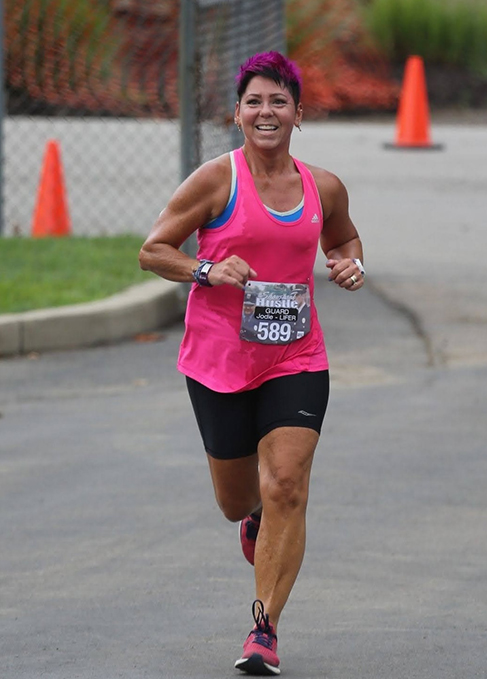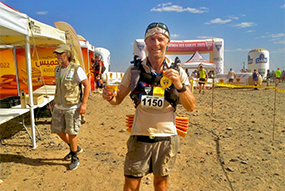Managing her diabetes ‘runner’s high’
Technology helps people living with diabetes manage the highs and lows of blood sugar

Jodie Snavely finds mental relaxation when she’s running. And she runs a lot — nearly every day.
Achieving that mental relaxation hasn’t always been easy, however. For years, Snavely’s type 1 diabetes (T1D) added stress, especially when it came to managing her blood sugar levels. She had to consider how much to eat before a long run, how much insulin to give herself, and how her levels changed during a workout.
“Trying to manage all that myself felt like a lot of guesswork,” recalls Snavely, 57, who today has several half-marathons under her belt. “And then after I stopped running, my blood sugar would still go up – sometimes really high.”
What is hyperglycemia?
High blood sugar, called hyperglycemia, occurs in people with diabetes when there is not enough insulin to regulate the amount of glucose in the blood. This can happen for several reasons, including not taking enough insulin after a meal, fluctuating hormones during monthly menstrual cycles, stress or illness, or dawn phenomenon (when individuals experience a rise in blood sugars in the early morning). Short-term effects include frequent urination, thirst, and fatigue.
When she experiences high blood sugar, Snavely recognizes it right away. “I feel sluggish with slight flu-like symptoms — just yucky and not as clear of mind.”
If left untreated, hyperglycemia can lead to serious health complications such as nerve damage, heart disease, kidney damage, and can even impact cognitive function.
High-tech to reduce highs

Some people who live with type 1 diabetes use exercise to help manage high blood sugars. But advances in technology have improved diabetes management in a more predictable way, allowing individuals to track their blood sugar levels closely and make necessary adjustments to their diet and medication.
Snavely relies on the newest technology to help keep highs in check: the MiniMedTM 780G system with Meal DetectionTM technology, which automatically adjusts and corrects sugar levels every five minutes. The device has been instrumental in preventing the blood sugar spikes she experienced after longer runs.
When she miscalculates how many carbohydrates she’s eaten, the system keeps her sugar levels where she wants them. As a result, she spends less time thinking and worrying about how her diabetes is affecting her life and her runs.
“My device helps me relax my mind and makes me not worry about ‘Did I give myself too much insulin?’ or ‘Did I not give enough?’” said Snavely. “Now I don’t have those spikes up and spikes down. My blood sugar levels are more even.”
That peace of mind enables the mental relaxation Snavely enjoys most during long-distance runs. And all those runs keep her feeling healthy — that matters to her. Her grandfather, who also had diabetes, died at age 51. She’s now 57, and plans for a long life.
“I love that when I’m running, I’m keeping myself healthy for as long as I possibly can. I’m not going to let diabetes take me down.”
L00104262024
Important Safety Information: MiniMed™ 780G System With SmartGuard™ Technology With Guardian™ 4 Sensor
The MiniMed™ 780G system is intended for continuous delivery of basal insulin at selectable rates, and the administration of insulin boluses at selectable amounts for the management of type 1 diabetes mellitus in persons seven years of age and older requiring insulin as well as for the continuous monitoring and trending of glucose levels in the fluid under the skin. The MiniMed™ 780G system includes SmartGuard™ technology, which can be programmed to automatically adjust insulin delivery based on the continuous glucose monitoring (CGM) sensor glucose values and can suspend delivery of insulin when the sensor glucose (SG) value falls below or is predicted to fall below predefined threshold values.
The Medtronic MiniMed™ 780G system consists of the following devices: MiniMed™ 780G insulin pump, the Guardian™ 4 transmitter, the Guardian™ 4 sensor, One-press serter, the Accu-Chek™ Guide Link blood glucose meter, and the Accu-Chek™ Guide test strips. The system requires a prescription from a healthcare professional.
The Guardian™ 4 sensor is intended for use with the MiniMed™ 780G system and the Guardian 4 transmitter to monitor glucose levels for the management of diabetes. The sensor is intended for single use and requires a prescription. The Guardian™ 4 sensor is indicated for up to seven days of continuous use.
The Guardian™ 4 sensor is not intended to be used directly to make therapy adjustments while the MiniMed™ 780G is operating in manual mode. All therapy adjustments in manual mode should be based on measurements obtained using a blood glucose meter and not on values provided by the Guardian™ 4 sensor. The Guardian™ 4 sensor has been studied and is approved for use in patients ages 7 years and older and in the arm insertion site only. Do not use the Guardian™ 4 sensor in the abdomen or other body sites including the buttocks, due to unknown or different performance that could result in hypoglycemia or hyperglycemia.
|
WARNING: Do not use the SmartGuard™ feature for people who require less than 8 units or more than 250 units of total daily insulin per day. A total daily dose of at least 8 units, but no more than 250 units, is required to operate in the SmartGuard™ feature. |
WARNING: Do not use the MiniMed™ 780G system until appropriate training has been received from a healthcare professional. Training is essential to ensure the safe use of the MiniMed™ 780G system.
WARNING: Do not use SG values to make treatment decisions, including delivering a bolus, while the pump is in Manual Mode. When the SmartGuard™ feature is active and you are no longer in Manual Mode, the pump uses an SG value, when available, to calculate a bolus amount. However, if your symptoms do not match the SG value, use a BG meter to confirm the SG value. Failure to confirm glucose levels when your symptoms do not match the SG value can result in the infusion of too much or too little insulin, which may cause hypoglycemia or hyperglycemia.
Pump therapy is not recommended for people whose vision or hearing does not allow for the recognition of pump signals, alerts, or alarms. The safety of the MiniMed™ 780G system has not been studied in pregnant women, persons with type 2 diabetes, or in persons using other anti-hyperglycemic therapies that do not include insulin. For complete details of the system, including product and important safety information such as indications, contraindications, warnings and precautions associated with system and its components, please consult https://www.medtronicdiabetes.com/important-safety-information#minimed-780g and the appropriate user guide at https://www.medtronicdiabetes.com/download-library
Related content



